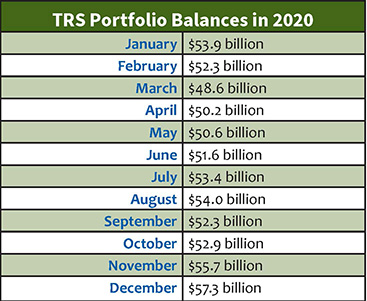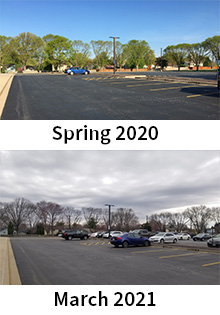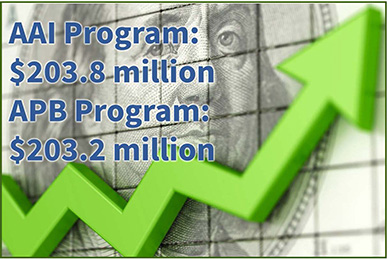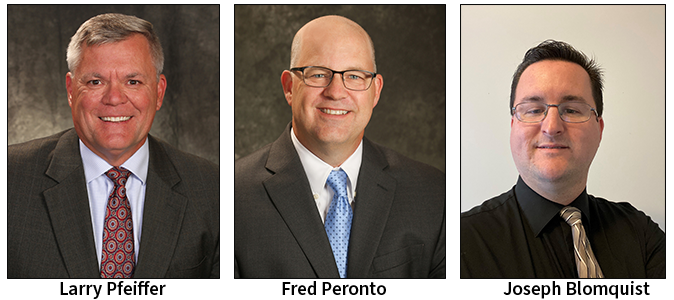TRS Investments End 2020 Strong and with a Record Balance
Despite the economic upheaval caused by the COVID-19 pandemic, Teachers’ Retirement System investments closed out calendar year 2020 with a positive 7.9 percent return.
At the start of 2021, the value of the TRS portfolio stood at $57.3 billion, which at the time was a record balance. At the end of February, the portfolio had increased to $58.3 billion, another record for TRS investments.
“Forethought and careful planning helped TRS successfully navigate the economic perils and uncertainties related to the pandemic,” said TRS Board President Devon Bruce. “The System’s strategic focus remains centered on a prudent, long-term allocation of assets to manage investment risk, protect assets during economic uncertainty and be poised to take advantage of economic growth possibilities.”
At the end of calendar year 2020, the $57.3 billion portfolio balance reflected a 17.9 percent rebound in asset value compared to the low point during the early months of the pandemic.
The System’s positive 7.9 percent investment return at the end of calendar year 2020 was due to strong performance between July and December. During those months, the TRS investment return was a positive 12.2 percent.
TRS maintains a focus on steady, long-term investment returns. The System recognizes that the majority of its members maintain relationships with TRS for decades. Even with the effects of the coronavirus pandemic, the TRS long-term investment returns continue to exceed the System’s long-term assumed investment return of 7 percent. The 40-year return for TRS at the end of calendar year 2020 was 9.3 percent.
Looking back on 2020, the defensive strategies employed by TRS to counteract the effects of the pandemic worked as intended. The System was able to minimize its losses and quickly reclaim value.

Like Its Members, TRS Determined to Overcome COVID-19 Challenges

In 2020, COVID-19 paralyzed almost everything.
And despite hopeful progress in combating the coronavirus in 2021, it continues to restrain our lives, our schools, our communities and our state.
Above all, the most difficult aspect of the pandemic has been the loss of family, friends and co-workers. To date, 402 TRS members have succumbed, each an irreplaceable loss.
But in spite of everything, we have endured personally and collectively. For the last year, we have moved forward with caution and confidence, determined to overcome the on-going challenge and return our lives back to the “old normal.”
For TRS, the year-long pandemic has not deterred the System from meeting all of its responsibilities to its 427,000 members. TRS staff has not cut back on member services. We are here for you.
Last March, the System closed its offices to visitors in order to comply with social distancing recommendations. In a few hectic days, TRS implemented preplanned “remote work” procedures and successfully converted all member assistance efforts to online and telephone platforms.
TRS offices remain closed to visitors, so all appointments with the System’s retirement counselors for the foreseeable future will continue to be held using Microsoft Teams, Zoom, webinars, social media, email and telephones. No date has been set yet for the resumption of in-person counseling sessions.
The System’s top priority during this unprecedented situation remains paying all benefits as usual to retired members and beneficiaries.
During 2020, TRS staff fulfilled its obligations. Approximately $7.1 billion in member benefits were paid on time and in full. More than 4,400 retirement claims were processed. In a recent week, the System’s Call Center and Counseling Services handled 3,141 telephone requests for assistance and approximately 800 emails.
TRS was able to accomplish a swift transition to a work-from-home platform because the System already had developed emergency contingencies in case the System’s offices were forced to close.
Over the last decade, the System had:
- Invested in the technology that enables staff to work remotely, if necessary.
- Implemented an external email system that allows us to contact close to 70 percent of all members with up-to-date information quickly.
- Digitized more than 384,000 paper records, which are now stored in a web-based repository that is more than 11 terabytes in size – approximately 12 million separate images.
- Created a detailed Business Continuity Plan which imagined the closure of TRS offices.
- Moved information technology functions to “the cloud,” which enhances remote work.
- Ran annual tests of TRS computer systems to confirm that all critical functions, especially the payment of benefits, could be accomplished in a “remote work” environment.
- Developed an internal “message tree” that enables TRS management to reach all staff with vital information in case the System’s offices are disabled.
The System also has enhanced its online member services to make it easier for users on both ends of the retirement process to conduct business. For instance, members now can electronically upload all completed TRS forms and documents instead of mailing them.
TRS also has ramped up its use of technology to bring members together for large group meetings. The 2020 Fall Member Meetings – a staple on the TRS calendar – were held online instead of in-person. More than 1,600 members attended 31 virtual meetings. And earlier this year, more than 1,950 members attended a new round of “pre-retirement webinars” to learn more about the retirement process.
Be prepared? TRS was prepared.
Accelerated Benefit Programs Update

More than 3,300 active and inactive TRS members have collected $407 million in accelerated pension benefits since 2019 under two state “buyout” programs designed to reduce the System’s total liabilities. Retired members are not eligible for either program.
TRS notifies active and inactive members who are eligible to participate in the buyout programs.
The average TRS lump-sum payout from both programs so far is $122,800.
Interest in the voluntary accelerated payments has proven to be so strong that state officials repeatedly have had to increase the amount of money appropriated to fund all of the lump-sums. In March, the state sold $100 million in bonds to fund the programs for the remainder of calendar year 2021. No TRS pension assets are used to fund the accelerated payments. By law the funding must come from the sale of state bonds.
Along with TRS, the “buyout” programs are administered by State Employees Retirement System and State Universities Retirement System.
Between the programs’ inception and March of 2021, 1,632 retiring Tier 1 TRS members elected to participate in the Accelerated Annual Increase (AAI) Program, or 17.4 percent of all retiring members during that time.
Altogether, these members received $203.8 million in lump-sum payments. In return, the future automatic annual increase in their pensions will start at age 67 and be 1.5 percent, not compounded. Retiring members who chose not to participate in the program will receive a 3 percent compounded annual increase starting at age 61. The average lump-sum payout for members participating in the AAI Program was $125,690.
During the six-month “participation windows” in 2019 and 2020 for the inactive member Accelerated Pension Buyout (APB) Program, 10.8 percent of 15,714 eligible members accepted a lump-sum payment and gave up all future claims to a TRS pension.
The 1,694 members who agreed to the program received a total of $203.2 million, with an average lump-sum of $120,053. Only inactive members who would be eligible for a future TRS pension can participate in this buyout program. The annual participation window for newly eligible inactive members begins in late September.
Three Candidates Obtain Required Nomination Signatures for Board Seats
No Election Planned

Trustees Fred Peronto, Larry Pfeiffer and Trustee-designate Joseph Blomquist were the only three prospective candidates who filed the 500 valid TRS member signatures that are required for nominations to the TRS Board of Trustees. If there had been more eligible candidates for any of the open seats, member balloting would have occurred throughout April, with the ballots counted on May 3.
Later this spring, the board will, by resolution, confirm all three candidates as members of the TRS Board of Trustees with their terms beginning on July 15.
A new addition to the board is Joseph Blomquist of St. Charles. Trustee-designate Blomquist will fill one of the two active board member seats.
The other active member seat will be filled by incumbent Trustee Fred Peronto of Elmhurst. Peronto was first elected to the board in 2017.
Incumbent Trustee Larry Pfeiffer of Carlinville was nominated and uncontested for the annuitant seat. Pfeiffer was first elected to the board in 2017.
Trustee-designate Blomquist is replacing Trustee Mark Bailey of Palos Park, who is retiring from the board after serving for eight years, the last two as vice president of the board.
The TRS Board of Trustees is comprised of 15 members – seven appointed by the governor, five elected by active members, two elected by annuitants and the sitting state superintendent of schools. One appointed seat is vacant currently.
Introducing Joseph Blomquist
Background:
- President of the St. Charles Education Association.
- Previously served as an elementary band and orchestra director in the St. Charles Community Unit District 303 in Kane County for 15 years.
- Bachelor’s in music education at the University of Illinois in Urbana-Champaign, 2000.
- Master’s in educational administration from Northern Illinois University, 2005.
- Currently obtaining second master’s degree in school business management from Northern Illinois University.
- Married to Meg for 16 years, daughters Lyla and Mallory.
What educational leadership positions have you held?
I currently serve as a member of the IEA Board of Directors and the IEA Executive Committee. I have also served on the ISBE task forces for remote learning in the spring and summer of 2020.
Why did you want to become a TRS board member?
I am passionate about supporting the work of educational professionals beyond the classrooms and school buildings, and I value engaging in work around financial data and maximizing system efficiencies to ensure that programs are sustainable and attract high quality individuals into the profession. Interestingly enough, if I had not pursued a career in education, I was also considering going into statistics, so this role is a perfect blend of those two areas.
What do you enjoy the most about your teaching career?
The greatest joy I find in working with students is helping young minds find their passion and their strengths in order to pave a path for their future. The same applies directly now as I work with adults, helping remove barriers and allowing educators to have a positive impact on their students through their own continuous pursuit of learning and personal discovery.
"It's Time to Retire" Webinar Meetings a Success
During January, February and March, the TRS Member Services Department scheduled 30 “It’s Time to Retire” webinars via WebEx for any members thinking about retirement during 2021.
The meetings were designed to explain how to initiate the retirement process. Counselors reviewed the retirement paperwork and provided members with valuable information about TRIP health insurance and the limits on post-retirement employment.
Response to this latest round of TRS webinars was quite good, indicating that retiring members are eager for information about the retirement process.
The response to these webinars also means that TRS is likely to offer similar sessions in future years. TRS is discussing the possibility of offering a series of “What’s Next?” sessions this summer for new retirees. These sessions would serve to remind freshly-minted annuitants about post-retirement matters including post-retirement limits, taxes and TRIP/TRAIL insurance enrollment/transition.
Following any summer webinar series, the Member Services Department will schedule its traditional Fall Member Meetings in September, October and November. These large group sessions, held via WebEx in 2020, are designed to help all members better understand TRS, not just those who are close to retirement.

“It’s Time to Retire” End of Season Statistics
Meetings Completed: 30
Total Registrations: 2,666
Total Attendance: 2,075
Percentage of Registrants Attending: 77.83%
Largest Meeting Attendance: 179 (inaugural event on 1/12/21 – before attendance limited to 100)
Smallest Meeting Attendance: 13 (numbers low for most meetings in the last 2 weeks of season)
Highest Percentage of Registrants Attending: 97% (1/26/21)
Average Meeting Attendance: 69
Illinois COVID-19 Vaccine Plan

View up-to-date information about Illinois' COVID-19 vaccine plan and vaccination eligibility from the State of Illinois on the Coronavirus Response website.
https://coronavirus.illinois.gov/s/vaccination-plan-overview
You can also locate this link on the TRS homepage.
Benefit Choice Period for Health Insurance Coverage Planned in May
The annual Benefit Choice Period for Teachers’ Retirement Insurance Program (TRIP) participants is planned for May 1 through June 1, 2021. TRS will post any updates about the Benefit Choice Period on our website.

This open enrollment period is not for members currently enrolled in the State of Illinois Medicare Advantage Prescription Drug (MAPD) Plan - Total Retiree Advantage Illinois (TRAIL). The open enrollment period for TRAIL participants will be held in the fall.
Benefit Choice is the time to make changes in TRIP coverage and to enroll yourself and eligible dependents.
TRS members and their dependents who have previously opted out of the Teachers' Retirement Insurance Program (TRIP) can re-enroll in the program if they wish. Re-enrollment is allowed only during the annual open enrollment period.
The information about the Benefit Choice Period will be mailed to retirees currently enrolled in TRIP by the end of April.
The mailing will include an explanation of health insurance options for the coming fiscal year beginning July 1, 2021 and any upcoming changes in insurance benefits.
The full Benefit Choice booklet will be available at http://www.benefitschoice.il.gov (the Illinois Department of Central Management Services [CMS] website) and also on MyBenefits.illinois.gov.
If you already are enrolled in TRIP and wish to make a change in coverage, call MyBenefits Service Center (MBSC) at 844-251-1777 or log in at MyBenefits.illinois.gov. If you are enrolling yourself for the first time during the Benefit Choice Period, please contact TRS for a TRIP Participation Election form.
If you do not want to change your coverage, you do not have to do anything. Your current coverage will continue.
TRS does not administer TRIP. As a reminder, TRS determines eligibility, assists with enrolling members in the program and collects appropriate premiums. By law, CMS is the administrator that determines coverage benefits, establishes premiums, negotiates contracts with the insurance carriers, and resolves coverage and claim issues.
MBSC is the custom benefits solution service provider for CMS and can answer questions about changing coverage or electing benefits.
Prepare for Retirement by Using This Tier 1 Retirement Time Line Checklist
Watch “It’s Time to Retire” video
If you are planning to retire in 2021, we encourage you to watch a virtual “It’s Time to Retire” meeting: https://www.trsil.org/videos/TimeToRetire. The meetings, held this past winter and early spring online, explain how to initiate the retirement process. Counselors review the retirement paperwork and provide members with valuable information about TRIP health insurance and post-retirement employment.
As Soon as Possible
- If you have not already submitted a “proof of birth” online in the Member Account Access area, it must be provided to TRS in order to process your retirement benefit.
- Update your years of service. Obtain the cost of reinstating a TRS refund, record sick leave from former employers and report optional service Types of optional service include:
- substitute teaching,
- homebound or part-time service before July 1, 1990,
- out-of-system service,
- military service,
- board-approved leaves of absence,
- leaves of absence due to pregnancy or adoption prior to July 1983, and
- involuntary layoffs.
- Update your Member Information and Beneficiary Designation (MIBD) form to ensure that survivor benefits will be paid according to your wishes.
- Provide us with your home email address in the secure Account Access area. Emails about legislation and other important events will also be sent periodically.
- Review the TRS Tier 1 Member Guide, www.trsil.org/Tier1_Member_Guide the TRS website.
- Inquire about upgrading your pre-July 1998 service to the 2.2 formula. Call us for the cost to upgrade.
- Consider consulting with a financial planner. TRS does not provide financial advice.
- Determine if any reciprocal service you have accrued will be beneficial to use in retirement. Each retirement system has specific rules about reinstating refunded service.
4 to 5 Years Before Retirement
- Attend a pre-retirement meeting. A schedule is available on the TRS website during the fall.
- Request a benefit estimate online in the secure Member Account Access area or by calling us. We will need to know your estimated retirement date; the number of unused, uncompensated sick leave days at retirement; and current and estimated future salary rates, including TRS contributions. Also include any bonuses and extra-duty pay.
2 Years Before Retirement
- Request an updated benefit estimate (online or by phone).
- Attend a pre-retirement meeting.
- Finish reporting all optional service; this task may take time and research.
- Complete payment to reciprocal system for refunded service, if applicable.
6 - 12 Weeks Before Retirement
- Complete the Personalized Retirement Interview by calling us or logging on to the Member Account Access area of our website. You’ll be asked a few questions that will complete information in the retirement packet for you. You will receive the packet within 15 working days. If you have reciprocal service, you also will need to call the other retirement system(s) to apply.
- Be certain you have provided us with your home email address in the secure Member Account Access area online. You will receive important information about the status of your retirement via email.
- Check on the status of any optional service or 2.2 balances still owed.
- During the retirement process, you will be asked how you wish to pay any remaining 2.2 balance. Payment can be made either through a lump sum, rollover, or pre-tax reduction from your monthly annuity check. If you have any optional service balances, they must be paid prior to retirement, with the exception of pregnancy or adoption leaves.
Spring 2021. Published by the Teachers' Retirement System of the State of Illinois.


